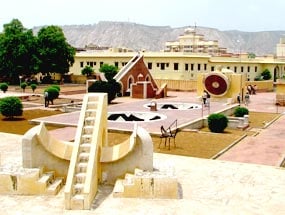Jantar Mantar of Jaipur is the largest stone
observatory in the world. Read about the Jantar Mantar of Rajasthan,
India.
Jantar Mantar of Jaipur

Location: Jaipur, Rajasthan
Founded By: Maharaja Jai Singh II
Founded In: 1727 -1733
Significance: Largest stone astronomical observatory in the
world
Status: National Monument
Jantar Mantar of Jaipur claims the distinction of being the largest
stone observatory in the world. It is situated near the City Palace
complex and was built by Maharaja Jai Singh II in the year 1727. It took
approximately six years to complete the observatory, which was even
designed by Jai Singh himself. Jantar Mantar of Jaipur is one of the
five astronomical observatories built by Maharaja all over the country.
The original name of the observatory was Yantra Mantra, meaning
instruments and formulae.
However, people mispronounced the name as 'Jantar Mantar' and gradually
this became the official name of the observatory. Jantar Mantar houses
an amazing collection of astronomical instruments. The most applaudable
feature of the observatory is that even after so many years it still
provides accurate information. The scientific settings and shapes of the
compound instruments of Jantar Mantar serve as a reminder of the
advancement of the Medieval Indian Astronomy. The entire structure of
Jantar Mantar has been constructed with stone and marble.
Metals have not been used in the construction of the observatory, since
metal instruments fell short of Jai Singh's expectations. It has
fourteen statistical instruments, which serve the purpose of measuring
time, predicting eclipses and ascertaining other astronomical events.
Jantar Mantar was renovated in the year 1901 and in 1948; it was
declared as a national monument. The most popular instrument of the
observatory is the Sundial, which is 27.4 m high and tells the time with
an accuracy of about two seconds.
Kranti Yantra
Kranti Yantra is a large instrument, which is used for measuring the
longitude and latitude of celestial bodies.
Diganta Yantra
Diganta Yantra is used to correctly ascertain the azimuth (arc of the
celestial great circle from Zenith to horizon) of the planetary bodies.
Small Ram Yantra and Large Ram Yantra
Both of the Ram Yantras, Small Ram Yantra as well as Large Ram Yantra,
are deployed for the purpose of finding the altitude and the azimuth.
However, the large yantra is 10 times larger than the smaller one and is
more accurate by 2 seconds.
Chakra Yantra
Chakra Yantra gives the angular measurement of an object from the
equator.
Jai Prakash Yantra
Jai Prakash Yantra determines the precise coordinates of celestial
bodies. It has a small iron plate, which is strung between the
crosswire. This plate is used to know the longitude and latitude of the
sun as well as and the zodiacal sign it is passing through.
Rashivalayas Yantra
Rashivalayas Yantra is quite similar in operation to the Samrat Yantra.
The yantra has a separate sundial for each of the zodiac signs. Five
sundials, those belonging to Gemini, Taurus, Cancer, Virgo and Leo, lie
at the back from north to south. Opposite them are the ones related to
Aries and Libra, followed by those of Aquarius, Pisces, Capricorn,
Scorpio and Sagittarius. Using this yantra, one can taking readings the
moment a zodiacal sign crosses the meridian.
Dakshina Yantra
Dakshina Yantra is basically a wall that is aligned with the
north-south meridian. It helps in determining the position and movement
of the celestial bodies at the time when they are passing over the
meridian.
Disha Yantra
Disha Yantra performs only one function, which is to point towards the
northern direction.
Unnathamsa Yantra
Unnathamsa Yantra helps in finding the elevation of the astronomical
bodies. The best part is that you can take readings anytime, and that to
from any portion of the dial.
Raj Yantra (King of Instruments)
Raj Yantra, the King of Instruments, is used in the preparation of the
Hindu calendar. For the purpose, a telescope is fixed over the central
hole and a sighting bar is attached at the back. The plain disk is used
to record the sightings.
Narivalya Yantra
Narivalya Yantra is a sundial, which has two dials. One of the dials
faces north when the sun is in the Northern Hemisphere, while the other
faces south for the rest of the year.
Dhruva Yantra
Dhruva Yantra determines the position of the Pole Star at night, along
with that of the 12 zodiac signs.
Samrat Yantra
Samrat Yantra is a triangular structure, with a huge sundial. The arc
on its left displays the time from sunrise to midday and the one on its
right displays the time from midday to sunset.


